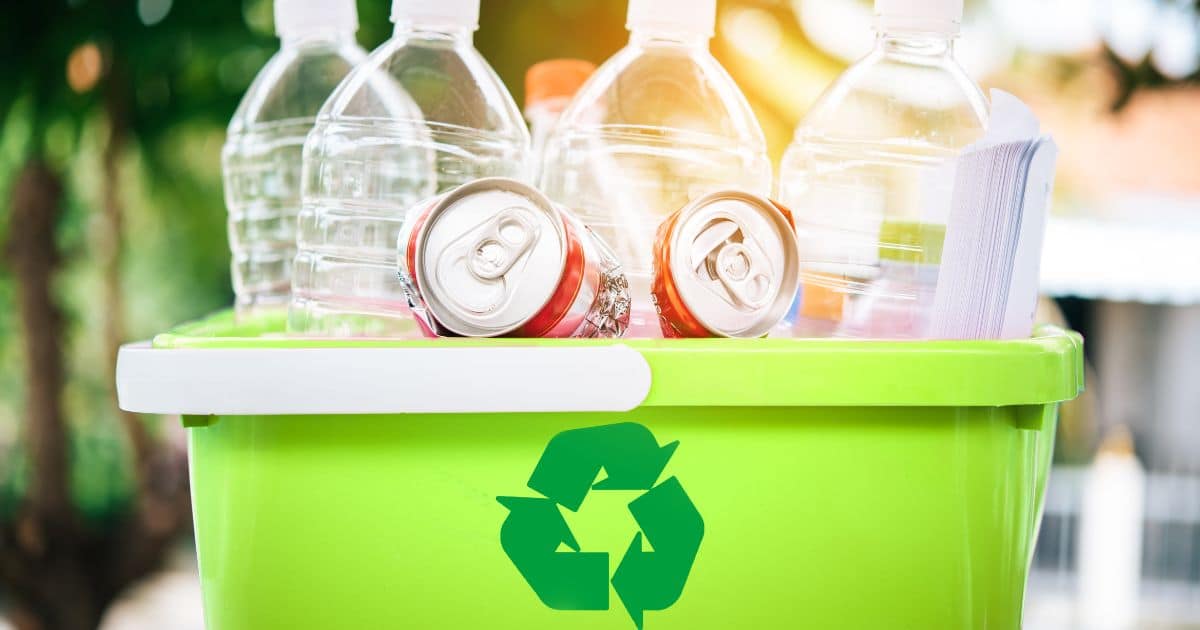Perspective
Critics Declared Veganism Dead in 2025. Here’s What Those Obituaries Are Missing.
Food•5 min read
Explainer
Symbols like ‘recyclable’ and ‘compostable’ aren’t as reliable as you’d expect.


Words by Jessica Scott-Reid
Consumers have become increasingly concerned about how their food is produced, and the impacts of their purchases. Recent research shows that 67 percent of Americans say “animal wellness” plays an important role in their purchasing decisions. There is also evidence that consumers are increasingly aware of the environmental impacts of product packaging, resulting in a willingness to pay for more sustainable alternatives. Shoppers look to certain food labels and symbols to answer: how does the production of this item affect the environment? Were the animals farmed for this food given enough space to move? Is this packaging recyclable or compostable?
But how accurate are food labels and symbols, and how many are mere marketing? We investigated some common ones that may not mean what you think they do.
As the beef industry faces scrutiny over its environmental impact, some big players in the space have begun promoting “climate-friendly” or “low-carbon” beef as a means to maintain consumer trust.
One example is Tyson’s Brazen Beef, which is marketed as “climate smart” and has an approved USDA label saying “10 percent greenhouse gas reduction.” However, researchers say that the company lacks clear metrics to support these claims. “In order to claim a 10 percent reduction, you need to establish scientifically a baseline that everyone agrees is the common amount that beef produces,” New York University environmental scientist Matthew Hayek told Corporate Knights Magazine. “There doesn’t seem to be any data that the company itself, or the government who it created that certification in conjunction with, is able to provide.”
The Food Safety and Inspection Service (FSIS) oversees the labeling of meat in the U.S. But as Hayek tells Sentient, “FSIS is a food inspection division, not an environmental analysis or conservation unit. They typically deal with food safety and standards of identity, so the environment is not in their wheelhouse.” He speculates that “this might explain why the climate claims that they allow on food products are so inconsistent with the science, opaque and vague on important details.”
The FSIS recently published new guidelines for climate and environmental claims on meat. The updated guidance “strongly recommends” producers provide the agency with data or studies to support claims, and to utilize third party certifiers to verify these claims. For now, however, these guidelines are recommended, not required.
The Animal Welfare Institute has long lobbied the U.S. Department of Agriculture for more transparency in the labeling of animal products as more “humane” or “eco-friendly.” In a statement, the group said it was “extremely disappointed” in the update. “While the revised guidelines are a small step in the right direction, they remain insufficient to combat misleading label claims used to market meat and poultry products,” said Zack Strong, acting director and senior attorney for AWI’s Farmed Animal Program.
For now, companies selling meat products labeled as “carbon-friendly” have not backed these claims up with substantial evidence, though some environmental groups, like the Environmental Working Group, see the new guidance as a step in the right direction.

Plastic packaging abounds. It is estimated that humans are responsible for between 380 to 459 million tons of plastic per year, with some reports indicating up to half of that is for single-use plastics, such as packaging for food and drinks. The Organization for Economic Co-operation and Development estimates that as of 2019, the life-cycle emissions of plastics, meaning production and disposal, is around 1.8 billion metric tons per year, or 3.4 percent of global emissions, “with 90 percent of these emissions from the production and conversion of plastics from fossil fuel feedstock,” according to the group’s report.
To help curb the amount of plastic filling up landfills, recycling programs were widely implemented across the U.S. in the late 1980s and early 1990s. Since then, both industrial and curbside recycling programs have grown, with many consumers now becoming accustomed to throwing plastics into their recycling bins. That said, the national recycling rate for the U.S. is only 35 percent over the last decade.
Lack of consumer participation isn’t the only challenge facing the U.S. recycling system. First off, there is no federal recycling program. Rather, “recycling decision-making is currently in the hands of 20,000 communities in the U.S., all of which make their own choices about whether and what to recycle,” Columbia University professor Kersten-Johnston told State of the Planet.
The Federal Trade Commision (FTC) works to enforce truthfulness in environmental marketing claims through its “Green Guides.” But it’s important to note those number and arrow symbols you see on plastic don’t actually indicate that an item is recyclable, but rather what type of plastic it is made of. Different regions and facilities have different recycling capabilities for different materials. This means that not every item that is marked with a recycling symbol can or will actually be recycled.
In fact, according to an extensive 2020 report by Greenpeace, only No. 1 and No. 2 bottles and jugs can legitimately be called and advertised as recyclable. “Plastics #3-7 have negligible-to-negative value,” according to the report, “and are effectively a category of products that municipal recycling programs may collect, but do not actually recycle. Plastic #3-7 waste collected in municipal systems across the country is being sent to landfills or incinerated.”
This confusion contributes to what is known as “wishcycling,” or the act of throwing things into the recycling bin in the hopes that it will be recycled. But items that are not recyclable can easily contaminate entire batches of materials, which can then land everything i in the trash. Simply not cleaning items properly can also lead to contamination and trashing — think peanut butter containers, laundry detergent bottles, yogurt containers, etc.

From party plates and takeout containers to coffee cups and even plastic bags, the market for compostable food packaging is booming. According to an industry report, the global compostable packaging market is currently worth $103.39 billion, and is expected to reach around $197.85 billion by 2032. The interest in compostable food packaging was born in part out of the known challenges with recycling.
Unfortunately, the compost industry faces some of the same challenges, including a lack of infrastructure. Products labeled “compostable” are only beneficial if they are actually composted, which requires either commercial composting programs (not all of which accept food packaging) or home composting systems — neither of which exist in abundance in the U.S.
So where are most compostable items ending up? One consumer survey found that 1/3 of people are putting them into the recycling bin, where they can end up contaminating recyclables, and eventually land in the landfill, where conditions are not favorable for breaking down compostables.
Research also shows that some items labeled as compostable don’t actually fully break down; one study found that up to 60 percent of compostable plastic failed to disintegrate after six months in home composting systems.
The American Society for Testing and Materials sets definitions and standards for compostable plastics, while the FTC is again responsible for enforcement against false or deceptive labeling. However, to be labeled as compostable, a product need only be able to break down in industrial composting facilities, which once again, are not yet widely available to everyday consumers.
The term “regenerative” broadly means an alternative method of producing food that may have lower, or even positive, environmental, animal welfare and social impacts. The practice focuses heavily on soil health, and promotes the notion that grazing animals are not only beneficial, but a key component in restoring soils.
There are two main regenerative labeling programs in the U.S.: Regenerative Organic Certified (ROC) and Certified Regenerative by A Greener World. Both go beyond the standards set by the USDA certified organic label, and both require animal welfare standards above baseline. This includes prohibiting long-term confinement, prohibiting tail docking and requiring pasture access throughout the grazing/growing season.
There are some limitations to these welfare standards, however. ROC, for example, does not prohibit the use of farrowing crates for pigs, nor does it require perches or dust baths for chickens. Both labeling programs are also not overseen by any government agencies, but rather by their own industry. Making the labeling claim that an animal was “Raised using Regenerative Agriculture Practices” simply requires documentation submitted by the company to the FSIS , which then must be approved by the agency.
But according to a 2022 report by the Animal Welfare Institute, that process of substantiation is severely lacking. “The USDA does not, for the most part, regulate the manner in which animals are raised or the impacts of agricultural production on the environment,” the group writes. “It is, however, supposed to deny the use of label claims deemed false or misleading, including those claiming positive animal welfare and environmental practices. To the extent the USDA evaluates label claims at all, it does so based solely on information the producer supplies in its label application.”
Regenerative labels can also mislead consumers. Evidence actually suggests that cattle grazing is environmentally harmful, requires a lot more land to produce the same amount of meat, and does not store carbon in the ground or significantly reduce emissions.
The “free-range” label on some meat, dairy and egg products often leads consumers to believe animals were raised more humanely than those in intensive confinement on factory farms. However, this isn’t always the case.
According to the USDA, “free-range” means animals have continuous outdoor access for just over 50 percent of their lives. But FSIS does not provide a clear definition of the term “free-range,” or related terms like “cage-free,” “pasture-raised,” “free-roaming” or “not confined.”
Once again, using this label is permitted without regulatory oversight. This allows manufacturers considerable flexibility in how they raise their so-called free-range animals; some may provide nearly continuous outdoor access, while others confine animals to cramped conditions, providing only minimal access to the outdoors.
When it comes to claims made about food production via labels and symbols, deciphering what is meaningful — and what is marketing — can be challenging. Consumers can face difficulty distinguishing between genuine sustainability and welfare efforts, or mere greenwashing and humanewashing. Ultimately, in a world full of labels, it’s wise to question what’s behind the curtain before buying into the story.